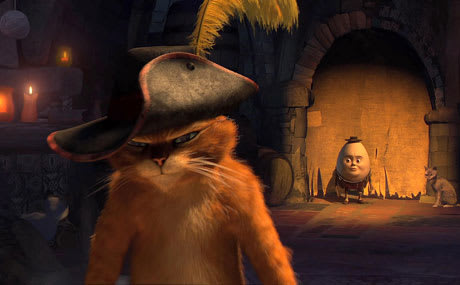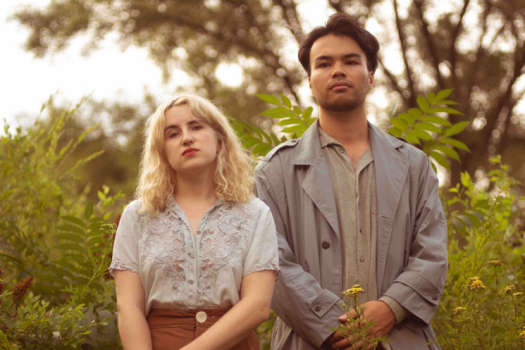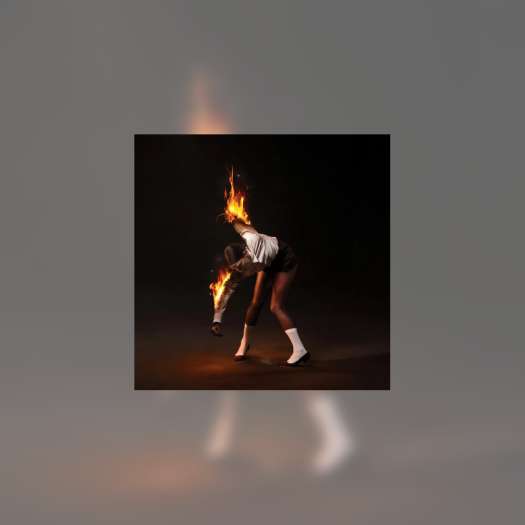Because the Shrek franchise has grown exceedingly stale, delivering rote, uninspired sequels with regurgitated gags and thematically murky subtext for the kiddies, it's important to note that aside from the titular character and a generalized whimsy about the fairy tale universe, this film is completely unrelated.
With an absurdly propulsive disposition, it takes place long before Shrek ― even jumping back to Puss's (Antonio Banderas) childhood as an orphan ― having an invigorating action/adventure tone that appropriately mirrors the style of Desperado (and other films of that oeuvre), which similarly featured Antonio Banderas and Salma Hayek.
Using stylized close-ups, split screen and deliberately framed action sequences, this mature kids' animation finds Puss reuniting with his best friend and archenemy, Humpty Dumpty (Zach Galifianakis), while on a quest to steal magic beans from the nefarious Jack (Billy Bob Thornton) and Jill (Amy Sedaris).
Having a troubled friendship involving conflicting morality and desperate tactical manipulations for kinship preservation, Puss reluctantly teams up with Humpty, mainly because of a crush on his comely partner-in-crime, Kitty Softpaws (Salma Hayek).
Beyond the impressively rendered 3D animation, which always has extreme depth and definition, potentially generating motion sickness while flying over vast desert space at ground level, the infectious tone of Puss in Boots is what makes it engage from beginning to end.
While some of the material is surprisingly dark, the clever exchanges between the characters and constant reminders that the suave Puss is a cat (puffing up when startled, cleaning himself provocatively, purring when given affection) ensure consistent laughs, energizing every scene with a vitality Shrek has long lost.
Even the inevitable dance sequence comes as a pleasant surprise, with Puss dragging his butt on the ground and Kitty Softpaws giving him the litter scratch while a variety of cats play salsa-inspired music in the background.
Such things could easily come off as grotesque and redundant, but the self-reflexive sense of humour and smartly sarcastic disposition of characters that actually have darkness in their psychological backgrounds make it all work.
Similarly, the indirect referential material, such as aesthetic Western stylizations and nods to the nursery rhyme kingdom, meld seamlessly with the story rather than standing out as clumsy afterthoughts.
It makes the somewhat despondent core message of growing away from childhood friends digestible for the kiddies while inspiring some thought in adults.
(Paramount Pictures)With an absurdly propulsive disposition, it takes place long before Shrek ― even jumping back to Puss's (Antonio Banderas) childhood as an orphan ― having an invigorating action/adventure tone that appropriately mirrors the style of Desperado (and other films of that oeuvre), which similarly featured Antonio Banderas and Salma Hayek.
Using stylized close-ups, split screen and deliberately framed action sequences, this mature kids' animation finds Puss reuniting with his best friend and archenemy, Humpty Dumpty (Zach Galifianakis), while on a quest to steal magic beans from the nefarious Jack (Billy Bob Thornton) and Jill (Amy Sedaris).
Having a troubled friendship involving conflicting morality and desperate tactical manipulations for kinship preservation, Puss reluctantly teams up with Humpty, mainly because of a crush on his comely partner-in-crime, Kitty Softpaws (Salma Hayek).
Beyond the impressively rendered 3D animation, which always has extreme depth and definition, potentially generating motion sickness while flying over vast desert space at ground level, the infectious tone of Puss in Boots is what makes it engage from beginning to end.
While some of the material is surprisingly dark, the clever exchanges between the characters and constant reminders that the suave Puss is a cat (puffing up when startled, cleaning himself provocatively, purring when given affection) ensure consistent laughs, energizing every scene with a vitality Shrek has long lost.
Even the inevitable dance sequence comes as a pleasant surprise, with Puss dragging his butt on the ground and Kitty Softpaws giving him the litter scratch while a variety of cats play salsa-inspired music in the background.
Such things could easily come off as grotesque and redundant, but the self-reflexive sense of humour and smartly sarcastic disposition of characters that actually have darkness in their psychological backgrounds make it all work.
Similarly, the indirect referential material, such as aesthetic Western stylizations and nods to the nursery rhyme kingdom, meld seamlessly with the story rather than standing out as clumsy afterthoughts.
It makes the somewhat despondent core message of growing away from childhood friends digestible for the kiddies while inspiring some thought in adults.




